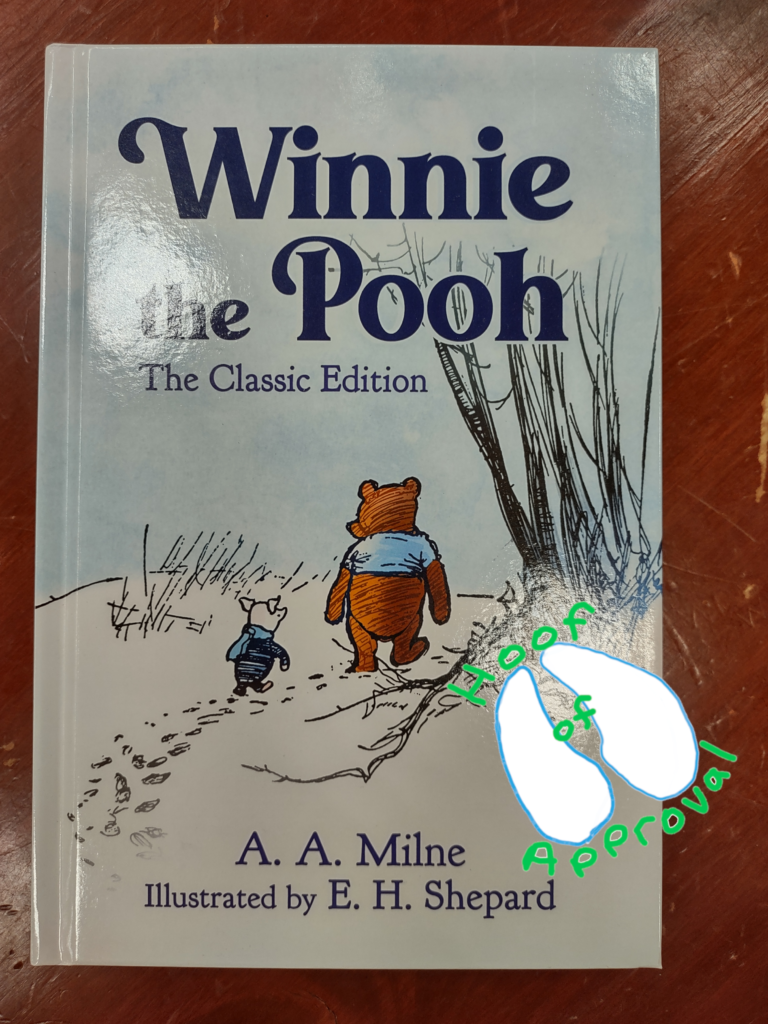
Tuesday, August 27, 2024
Winnie-the-Pooh
by A.A. Milne, decorations by E.H. Shepard
Who hasn’t heard of the lovably round and hungry bear and his adventures with his zany friends in the Hundred Acre Wood? In children’s hands since 1926, AA Milne’s book is a mental wonderland that seems to capture attention at will.
A few of the myriad accolades are listed here: ranked #26 of top 100 children’s novels by School Library Journal; after translation to Latin, became the first foreign-language book to be featured in the New York Times Best Seller list; and was the “starter” book for Apple’s iBooks app.

So what’s the big deal? The book is broken up into ten short stories that do not have to be read in order to be understood. The writing is light and not complex. The storylines are funny. This makes for easy, repetitive reading, which makes for great bedtime storytelling.
I like to think the tone of the narrator had something to do with it, too. The narrator, only referred to as Mr. Narrator, talks to Christopher Robin, and the characters themselves with such likeable resignation, it’s as if we’re privy to a conspiratorial father-son read-along. It reminds me of JK Rowling’s first few Harry Potter books, where she used tone to help the reader understand the type of people the Dursleys were.
The characters, although anthropomorphically cute, are actually fleshed out with realistic motivations, such as the Owl, known for the being the wise one, who tricked Rabbit into reading a notice, because he didn’t want to let on that he couldn’t read. Or when Rabbit insults Pooh ‘kindly’. The contrast has to make kids think, at least subconsciously, that something doesn’t sit quite right, that context exists and face value isn’t always true value. Check out this article from The Guardian’s Sarah Burnside for her point of view. Revisiting Winnie-the-Pooh: more cutting than we thought when we were six | Books | The Guardian
Controversy? The only female character in the book is a mother kangaroo named Kanga. And her story is where the other characters try to play a joke on her by switching her baby, Roo, with Piglet. Christopher Robin’s mother is not in the book, so this has led to a few reviews with a feminist lens. Take a look at two articles that scrutinize the book in the same way, but with different takeaways. One, written by Colin Wilcockson about Claudia von Strassenbahn’s feminist interpretation Winnie-the-Pooh: von Strassenbahn’s feminist interpretation (poohsoc.org.uk) and one by Carol A. Stranger via ResearchGate’s website (PDF) The Survival of a Woman: A Feminist Approach to Winnie-the-Pooh and The House at Pooh Corner (researchgate.net)
And check out this article, Unhu and Winnie the Pooh (childlitassn.wixsite.com) from Katherine J. Dubke about applying the Unhu gaze, a Zimbabwean literary theory that applies African wisdom and values to reading. Great read!
Ultimately, there’s been 70 years of translations, sequels, and animated adaptations which have kept Winnie the Pooh in the forefront of children’s literature.
I’ve a different take on this book now, than when I read it as a child. It’s lot more nuanced than I remembered. Is it still relevant in today’s world and with today’s child? You decide! With that, Mrs. Udderbutter stamps her Hoof of Approval!
Have fun reading!
